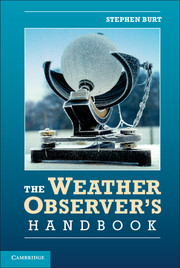Book contents
- Frontmatter
- Contents
- Acknowledgements
- Abbreviations, footnotes and references
- Part One The basics
- Part Two Measuring the weather
- 5 Measuring the temperature of the air
- 6 Measuring precipitation
- 7 Measuring atmospheric pressure
- 8 Measuring humidity
- 9 Measuring wind speed and direction
- 10 Measuring grass and earth temperatures
- 11 Measuring sunshine and solar radiation
- 12 Observing hours and time standards
- 13 Dataloggers and AWS software
- 14 Non-instrumental weather observing
- 15 Calibration
- 16 Metadata – what is it, and why is it important?
- Part Three Making the most of your observations
- Appendix 1 Metrology and meteorology: The basics of instrument theory
- Appendix 2 Useful functions
- Appendix 3 Unit conversions
- Appendix 4 Useful sources
- Index
- References
10 - Measuring grass and earth temperatures
Published online by Cambridge University Press: 05 July 2012
- Frontmatter
- Contents
- Acknowledgements
- Abbreviations, footnotes and references
- Part One The basics
- Part Two Measuring the weather
- 5 Measuring the temperature of the air
- 6 Measuring precipitation
- 7 Measuring atmospheric pressure
- 8 Measuring humidity
- 9 Measuring wind speed and direction
- 10 Measuring grass and earth temperatures
- 11 Measuring sunshine and solar radiation
- 12 Observing hours and time standards
- 13 Dataloggers and AWS software
- 14 Non-instrumental weather observing
- 15 Calibration
- 16 Metadata – what is it, and why is it important?
- Part Three Making the most of your observations
- Appendix 1 Metrology and meteorology: The basics of instrument theory
- Appendix 2 Useful functions
- Appendix 3 Unit conversions
- Appendix 4 Useful sources
- Index
- References
Summary
After air temperature, grass and earth temperatures are the most commonly observed surface climatological parameters. This chapter describes the methods used to measure temperatures other than those of the air, and includes reference to the relevant WMO guidance [1].
The grass minimum
Why measure grass temperature? Assuming there are no obstructions to outgoing radiation to space, the lowest temperatures on a clear night will be recorded at or close to ground level, where stirring and mixing of the cooling air by wind is at its minimum. The nature of the surface, primarily whether it is a good or bad conductor of heat upwards from the earth, then determines its temperature under such conditions. Where the surface is covered by short grass, the lowest temperatures are attained just above the tips of the grass blades, because air trapped between the grass blades acts as a partial insulator to the upward heat transfer (‘heat flux’) from the warmer earth beneath.
In many countries, the so-called ‘grass minimum temperature’ (or ‘grass min’) is measured using a thermometer or electrical sensor freely exposed at the tip of the grass blades (Figure 10.1). In the UK, grass minimum temperatures have been measured in this fashion since the 1850s. Recently, some AWSs have begun to monitor surface temperatures using a downward-pointing infrared sensor mounted about 2 m above ground level. Grass or surface minimum temperatures are sometimes referred to as the ‘radiation minimum’ or ‘skin temperature’.
- Type
- Chapter
- Information
- The Weather Observer's Handbook , pp. 222 - 231Publisher: Cambridge University PressPrint publication year: 2012



